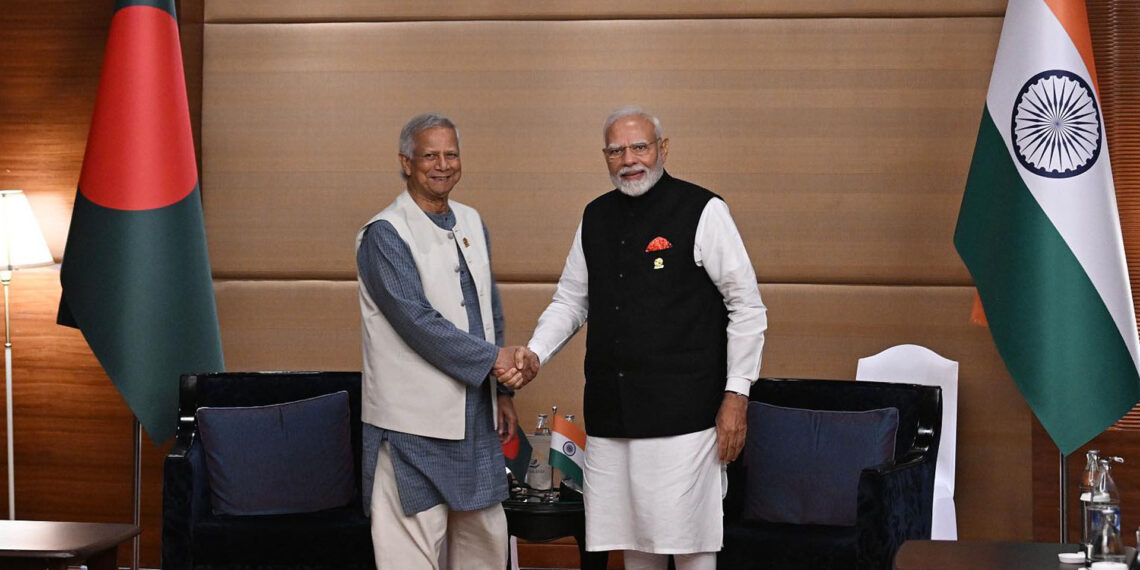On March 21, Ministry of External Affairs spokesperson Randhir Jaiswal said that he did “not have any update to share at this point in time” on any likely meeting between Prime Minister Narendra Modi and Bangladesh interim authority Chief Advisor Mohammad Yunus, in Bangkok.
This was in response to a media report the same day that it was “unlikely” there would be a “formal meeting on the margins” of the BIMSTEC event.
Then, a week later, an MEA press release, focused on the Bangkok BIMSTEC Summit, did not have a word on any meeting between Modi and Yunus, indicating that the Indian position – that there would be no formal meeting between the two – remained unchanged.
Even as leaders representing the BIMSTEC member states gathered at Bangkok on April 3, Modi and Yunus were photographed sitting next to each other – both appearing stony-faced and grim.
By the afternoon of April 4, everything had changed. Modi, along with a battery of senior MEA officials – excluding External Affairs Minister S Jaishankar and National Security Advisor Ajit Doval – waited at the lobby of, presumably, a hotel, as hosts to welcome Yunus and his retinue of officials.
This followed a 30-minute bilateral meeting – no less – in which both sides raised issues of mutual concern.
Now, the moot question is: what transpired in the span of less than 12 hours for this meeting, which the Bangladeshis desperately sought, to materialise?
More importantly, what changed between August 5, 2024, when Prime Minister Sheikh Hasina fled to India, a prolonged period of hostile, anti-India diatribes by Yunus himself, the other advisers on the interim authority and the rabble-rousing students who are part of, and strongly back, the interim authority?
It is understandable that the Indian reticence to engage with an interim authority was largely based on the belief that this was not a democratically elected body; it had seized power as a consequence of street power and violence.
The Indian establishment’s sudden and surprising change in policy within a short span of time begs the question – what or who pushed the national security and external affairs bureaucracy to engage with the Yunus administration that had recently sought to provoke the Indians with the Bangladeshi chief advisor’s provocative statements on India’s northeast during his visit to China?
At this point in time, the main candidate – the inducer – is a section of the US national intelligence and military – which seeks to play a proactive role in Myanmar in general and the Rakhine State in particular to achieve its own goals.
Towards this end, a key ally would be the Bangladesh Army led by its chief General Waker-uz-Zaman.
While the Indian and Bangladeshi media have projected the story of the Yunus-Modi meeting from their own narrow, national perspectives, an inescapable point is that this bilateral meeting couldn’t have happened without some “active push” from a section of the US intelligence-military establishment which seeks an early conclusion of military operations in the Rakhine State which the Arakan Army is close to take full control over.
The Indian national security establishment lost control over Bangladesh on August 5, 2024, when Sheikh Hasina fled Dhaka for safe haven in India. It sought to woo the BNP – and may still be doing so – but its main bet is the powerful and influential Army led by Gen Waker-uz-Zaman.
Today’s Yunus-Modi meeting sent out a clear signal to Gen Zaman that not India but the US remains in the driving seat insofar as regional geopolitical realities are concerned.
Gen Zaman, by all accounts, is not a risk-taker but more of a status quoist and he is expected to act in the best interest of his country – and himself.
Till the other day, he was not prepared to commit his forces to any defensive operation along the Myanmar-Bangladesh border, but in the backdrop of the changed realities – as evidenced by Modi’s decision to meet Yunus, till recently a pariah for New Delhi – he might well do so now.
Over the last few months, Gen Zaman has shown himself to be not so much a ‘field soldier’ as much as a ‘backroom manoeuvrer’ comfortable with switching sides as the situation demands.















